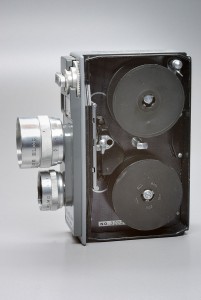
Standard 8mm film, also known as Double 8mm film or simply as Regular-8 or Standard-8, is a cine film format that was introduced by Eastman-Kodak in 1932. Until then, only 16 mm formats had been available; the new format was intended for hobby filmmakers usage.
Normal 8 films use a 16mm tape that has twice the number of perforation holes.
First, one half of the tape is exposed, then the camera must be opened and the tape rotated so that the other half can be recorded on. During development, the strip is cut in half and joined together to form a film. This is where the name Double 8 format comes from. This process made it possible to produce smaller cameras and made both equipment and film material affordable for private households.
Standard-8 film tapes had to be inserted carefully into the camera. The tape was not supposed to be exposed to light. Loading should therefore take place in semi-darkness if possible. The Standard-8 tape had to be turned over just as carefully after exposing the first half. For this purpose, there was a so-called changing bag, which was supposed to make it easier to change the film on the go. It was put over the camera to prevent unintentional exposure of the film when it was taken out.
One disadvantage of the Double 8 format were the wide perforation holes, which reduced the image area to 3.28mmx4.37mm. To allow a greater exposed area, Eastman-Kodak developed the Super 8 format, which came onto the market in 1965. The Super 8 film had an 8mm strip with narrower perforation holes, so that the image section was enlarged to 4.01mmx5.36mm, that’s by half more.


